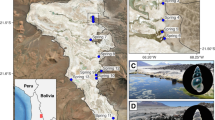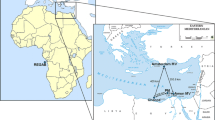Abstract
The patchy distribution of rocky intertidal communities in the tropical eastern Pacific (TEP) may impose severe constraints on the genetic connectivity among populations of marine invertebrates associated with this habitat. In this study, we analyzed a portion of the mitochondrial cytochrome c oxidase subunit I (COI) gene in two sympatric species of marine snails, Nerita scabricosta and Nerita funiculata, common inhabitants of the rocky intertidal from the Gulf of California (Sea of Cortez) and outer Pacific coast of the southern Baja California (Baja) peninsula to northern South America, to assess genetic connectivity among populations of each species. One of our aims was to determine whether the morphological, behavioral, and ecological differences observed among populations of both species throughout their range in the TEP corresponded to population genetic differences. In addition, we were interested in elucidating the demographic history of both species. We found no evidence of genetic structure throughout the Gulf of California and outer coast of the Baja peninsula region for either species. Comparisons between Gulf of California/Baja and Panama populations, however, showed significant genetic differentiation for N. scabricosta, but not for N. funiculata. The genetic differences between Mexican and Panamanian populations of N. scabricosta were consistent with previously reported ecological and behavioral differences for this species between these two distant regions. However, previously reported size differences between northern and central/southern Gulf of California individuals of N. scabricosta do not correspond with our findings of genetic connectivity among these populations. Results from neutrality tests (Tajima’s D and Fu’s FS), the mismatch distribution, and Bayesian skyline analyses suggested that both species have experienced dramatic population expansions dating to the Pleistocene.



Similar content being viewed by others
References
Alvarez-Borrego S (2002) Physical oceanography. In: Case TJ, Cody ML, Ezcurra E (eds) A new island biogeography of the Sea of Cortes. Oxford University Press, New York, pp 41–59
Aris-Brosou S, Excoffier L (1996) The impact of population expansion and mutation rate heterogeneity on DNA sequence polymorphism. Mol Biol Evol 13:494–504
Arnaud S, Monteforte M, Galtier N, Bonhomme F, Blanc F (2000) Population structure and genetic variability of pearl oyster Pinctada mazatlanica along Pacific coasts from Mexico to Panama. Conserv Genet 1:299–307
Aubert H, Lightner DV (2000) Identification of genetic populations of the Pacific blue shrimp Penaeus stylirostris of the Gulf of California, Mexico. Mar Biol 137:875–885
Bernardi G, Findley L, Rocha-Olivares A (2003) Vicariance and dispersal across Baja California in disjunct marine fish populations. Evolution 57:1599–1609
Bertness MD, Garrity SD, Levings SC (1981) Predation pressure and gastropod foraging: a temperate-tropical comparison. Evolution 35:995–1007
Bovbjerg RV (1984) Habitat selection in two intertidal snails, genus Nerita. Bull Mar Sci 34:185–196
Briggs JC (1974) Marine zoogeography. McGraw-Hill, New York
Brower AVZ (1994) Rapid morphological radiation and convergence among races of the butterfly Heliconius erato inferred from patterns of mitochondrial DNA evolution. Proc Natl Acad Sci USA 91: 6491–6495
Brusca RC (1980) Common intertidal invertebrates of the Gulf of California, 2nd edn. University of Arizona Press, Tucson
Brusca RC, Brusca GJ (2003) Invertebrates. Sinauer Associates, Sunderland
Calderón-Aguilera LE, Marinone SG, Aragón-Noriega EA (2003) Influence of oceanographic processes on the early life stages of the blue shrimp (Litopenaeus stylirostris) in the Upper Gulf of California. J Mar Syst 39:117–128
Castro R, Mascarenhas AS, Durazo R, Collins CA (2000) Seasonal variation of the temperature and salinity at the entrance to the Gulf of California, Mexico. Ciencias Marinas 26:561–583
Correa-Sandoval F, Carvacho-Bravo A (1992) Efecto de la “Barrera de las Islas” en la distribución de los braquiuros (Crustacea: Decapoda) en el Golfo de California. Proc San Diego Soc Nat Hist 26: 1–4
Cushman JH (1989) Vertical size gradients and migratory patterns of two Nerita species in the northern Gulf of California. The Veliger 32:147–151
de la Rosa-Vélez J, Escobar-Fernández R, Correa F, Maqueda-Cornejo M, de la Torre-Cueto J (2000) Genetic structure of two commercial penaeids (Penaeus californiensis and P. stylirostris) from the Gulf of California, as revealed by allozyme variation. Fish Bull (Wash DC) 98: 674–683
Drummond AJ, Rambaut A, Shapiro B, Pybus OG (2005) Bayesian coalescent inference of past population dynamics from molecular sequences. Mol Biol Evol 22: 1185–1192
Excoffier L, Smouse PE, Quattro JM (1992) Analysis of molecular variance inferred from metric distances among DNA haplotypes: application to human mitochondrial DNA restriction data. Genetics 131:479–491
Excoffier L, Laval G, Schneider S (2005) Arlequin ver. 3.0: An integrated software package for population genetics data analysis. Evol Bioinform Online 1:47–50
Folmer O, Black M, Hoeh W, Lutz R, Vrijenhoek R (1994) DNA primers for amplification of mitochondrial cytochrome c oxidase subunit I from diverse metazoan invertebrates. Mol Mar Biol Biotech 3:294–299
Fu Y-X (1997) Statistical tests of neutrality of mutations against population growth, hitchhiking and background selection. Genetics 147: 915–925
Garrity SD, Levings SC (1981) A predator–prey interaction between two physically and biologically constrained tropical rocky shore gastropods: direct, indirect and community effects. Ecol Monogr 51:267–286
Grosberg RK, Cunningham CW (2001) Genetic structure in the sea: from populations to communities. In: Bertness MD, Gaines S, Hay ME (eds) Marine community ecology. Sinauer Associates, Sunderland, pp 61–84
Gutiérrez OQ, Marinone SG, Parés-Sierra A (2004) Lagrangian surface circulation in the Gulf of California from a 3D numerical model. Deep Sea Res Part II- Top Stud Oceanogr 51:659–672
Harpending H (1994) Signature of ancient population growth in a low-resolution mitochondrial DNA mismatch distribution. Hum Biol 66:591–600
Hastings PA (2000) Biogeography of the tropical eastern Pacific: distribution and phylogeny of chaenopsid fishes. Zool J Linnean Soc 128:319–335
Hellberg ME, Vacquier VD (1999) Rapid evolution of fertilization selectivity and lysine cDNA sequences in teguline gastropods. Mol Biol Evol 16:839–848
Helenes J, Carreño AL (1999) Neogene sedimentary evolution of Baja California in relation to regional tectonics. J South Am Earth Sci 12:589–605
Houston RS (1980) Mollusca. In: Brusca RC (ed) Common intertidal invertebrates of the Gulf of California, 2nd edn. The University of Arizona Press, Tucson, pp 130–204
Houston RS (1990) Reproductive systems of neritimorph archeogastropods from the eastern Pacific, with special reference to Nerita funiculata Menke, 1851. The Veliger 33:103–110
Huang D, Bernardi G (2001) Disjunct Sea of Cortez-Pacific Ocean Gillichthys mirabilis populations and the evolutionary origin of their Sea of Cortez endemic relative, Gillichthys seta. Mar Biol 138:421–428
Hurtado LA, Mateos M, Lutz RA, Vrijenhoek RC (2003) Coupling of bacterial endosymbiont and mitochondrial genes in the hydrothermal vent clam Calyptogena magnifica. Appl Environ Microbiol 69: 2058–2064
Hurtado LA, Lutz RA, Vrijenhoek RC (2004) Distinct patterns of genetic differentiation among annelids of eastern Pacific hydrothermal vents. Mol Ecol 13: 2603–2615
Keen AM (1971) Sea shells of tropical west America; marine mollusks from Baja California to Peru. Stanford University Press, Stanford
Kimura M (1980) A simple method for estimating evolutionary rate of base substitutions through comparative studies of nucleotide sequences. J Mol Evol 16:111–120
Knowlton N, Weigt LA, Solórzano LA, Mills DK, Bermingham E (1993) Divergence in proteins, mitochondrial DNA, and reproductive compatibility across the Isthmus of Panama. Science 260:1629–1632
Kumar S, Tamura K, Nei M (2004) MEGA3: integrated software for molecular evolutionary genetics analysis and sequence alignment. Brief Bioinform 5:150–163
Lessios HA, Kane J, Robertson DR (2003) Phylogeography of the pantropical sea urchin Tripneustes: contrasting patterns of population structure between oceans. Evolution 57: 2026–2036
Levings SC, Garrity SD (1983) Diel and tidal movement of two co-occurring neritid snails: differences in grazing patterns on a tropical rocky shore. J Exp Mar Biol Ecol 67:261–278
Lewis JB (1960) The fauna of rocky shores of Barbados, West Indies. Can J Zool 38:391–435
Nei M (1987) Molecular evolutionary genetics. Columbia University Press, New York
Palumbi SR (1994) Genetic divergence, reproductive isolation, and marine speciation. Annu Rev Ecol Syst 25:547–572
Passamonti M, Scali V (2001) Gender-associated mitochondrial DNA heteroplasmy in the venerid clam Tapes philippinarum (Mollusca Bivalvia). Curr Genet 39:117–124
Pfeiler E, Hurtado LA, Knowles LL, Torre-Cosío J, Bourillón-Moreno L, Márquez-Farías JF, Montemayor-López G (2005) Population genetics of the swimming crab Callinectes bellicosus (Brachyura: Portunidae) from the eastern Pacific Ocean. Mar Biol 146:559–569
Posada D, Crandall KA (1998) Modeltest: testing the model of DNA substitution. Bioinformatics 14:817–818
Ray N, Currat M, Excoffier L (2003) Intra-deme molecular diversity in spatially expanding populations. Mol Biol Evol 20:76–86
Riginos C, Nachman MW (2001) Population subdivision in marine environments: the contribution of biogeography, geographical distance and discontinuous habitat to genetic differentiation in a blennioid fish, Axoclinus nigricaudus. Mol Ecol 10:1439–1453
Riginos C, Victor BC (2001) Larval spatial distributions and other early life-history characteristics predict genetic differentiation in eastern Pacific blennioid fishes. Proc R Soc Lond B 268:1931–1936
Sandoval-Castillo J, Rocha-Olivares A, Villavicencio-Garayzar C, Balart E (2004) Cryptic isolation of Gulf of California shovelnose guitarfish evidenced by mitochondrial DNA. Mar Biol 145:983–988
Schneider S, Excoffier L (1999) Estimation of past demographic parameters from the distribution of pairwise differences when the mutation rates very among sites: application to human mitochondrial DNA. Genetics 152: 1079–1089
Soulé JD (1960) The distributions and affinities of the littoral marine Bryozoa (Ectoprocta). Symposium on the biogeography of Baja California and adjacent seas. Part II. Mar Biotas Syst Zool 9:100–104
Stepien CA, Rosenblatt RH, Bargmeyer BA (2001) Phylogeography of the spotted sand bass, Paralabrax maculatofasciatus: divergence of Gulf of California and Pacific Coast populations. Evolution 55: 1852–1862
Tajima F (1983) Evolutionary relationships of DNA sequences in finite populations. Genetics 105:437–460
Tajima F (1989) Statistical method for testing the neutral mutation hypothesis by DNA polymorphism. Genetics 123:585–595
Tajima F (1996) The amount of DNA polymorphism maintained in a finite population when the neutral mutation rate varies among sites. Genetics 143:1457–1465
Terry A, Bucciarelli G, Bernardi G (2000) Restricted gene flow and incipient speciation in disjunct Pacific Ocean and Sea of Cortez populations of a reef fish species, Girella nigricans. Evolution 54:652–659
Thomson DA, Findley LT, Kerstitch AN (2000) Reef fishes of the Sea of Cortez. The University of Texas Press, Austin
Vermeij GJ (2001) Distribution, history, and taxonomy of the Thais clade (Gastropoda: Muricidae) in the Neogene of tropical America. J Paleontol 75:697–705
Walker BW (1960) The distributions and affinities of the marine fish fauna of the Gulf of California. Symposium on the biogeography of Baja California and adjacent seas. Part II. Mar Biotas Syst Zool 9:123–133
Waters JM, King TM, O’Loughlin PM, Spencer HG (2005) Phylogeographical disjunction in abundant high-dispersal littoral gastropods. Mol Ecol 14:2789–2802
Zouros E, Ball AO, Saavedra C, Freeman KR (1994) An unusual mitochondrial DNA inheritance in the blue mussel Mytilus. Proc Natl Acad Sci USA 91:7463–7467
Acknowledgments
We thank Mariana Mateos, Rick Grosberg, Geerat Vermeij, and Wain Evans for their helpful suggestions on the manuscript and/or study, and M. Mateos and Harilaos Lessios for collecting specimens. This study was supported by National Science Foundation grants HR-0123325, DEB-9510645 and DEB-0346773 to T.A. Markow and IBN-0416713 to R. Grosberg, and a grant of the Andrew W. Mellon Foundation to R. Grosberg.
Author information
Authors and Affiliations
Corresponding author
Additional information
Communicated by P.W. Sammarco.
Rights and permissions
About this article
Cite this article
Hurtado, L.A., Frey, M., Gaube, P. et al. Geographical subdivision, demographic history and gene flow in two sympatric species of intertidal snails, Nerita scabricosta and Nerita funiculata, from the tropical eastern Pacific. Mar Biol 151, 1863–1873 (2007). https://doi.org/10.1007/s00227-007-0620-5
Received:
Accepted:
Published:
Issue Date:
DOI: https://doi.org/10.1007/s00227-007-0620-5




